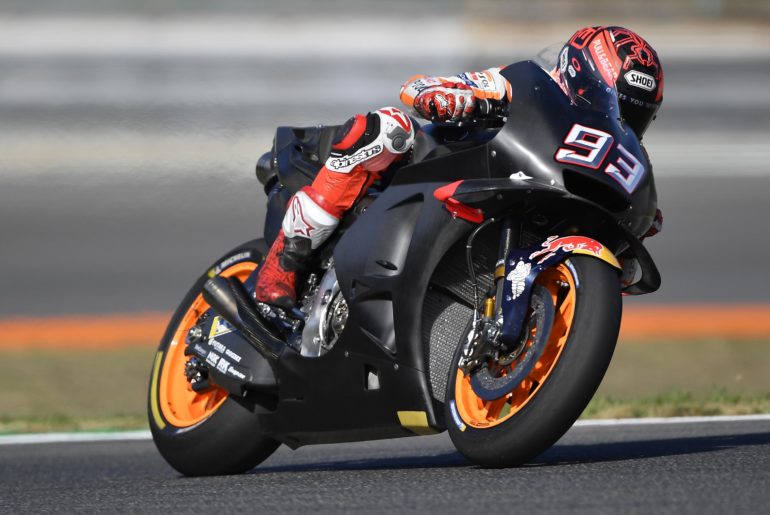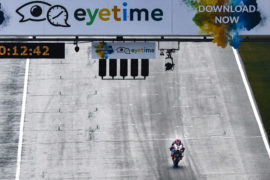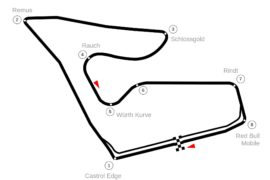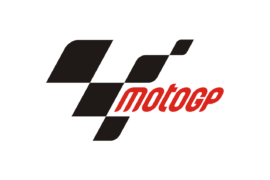You would think that after a tough weekend of racing in punishing conditions, the riders would find it very hard to spend eight hours on a MotoGP bike, pushing as close to race pace as possible, testing new parts and setup.
Not according to Andrea Dovizioso. “No, for me it’s very easy, and it’s the easiest way to do that. If there is a break, it’s worse,” he told us at the end of Monday’s test at Brno.
There was a pretty full cast of MotoGP characters present, with one or two notable exceptions. The Reale Avintia and Angel Nieto Team Ducati teams were both absent, because they had nothing to test except setup, and testing is expensive.
Pol Espargaro was in the hospital waiting for scans on his broken collarbone and his back, which confirmed that luckily only his collarbone was fractured, and it won’t need to be plated (though he will definitely miss KTM’s home race at the Red Bull Ring in Austria).
HRC test rider Stefan Bradl was also absent, after stretching ligaments in his right shoulder in a crash he caused on the first lap. A crash in which he also took out Maverick Viñales, who also suffered a minor shoulder injury, and decided not to test.
Given the massive tension in Viñales’ garage at the moment between him and his crew, skipping the test may have been the best option anyway.
Yamaha Improves
That left Valentino Rossi with plenty of work to do, but the outcome of the test was positive, Rossi said. “We worked for the acceleration, for the first touch of the throttle and also to try to save the tire for the race,” he explained.
“We tried different things, we found something good, but we have to put all together. So unfortunately at this moment we are not able to improve the performance of yesterday. So I think that for Austria the situation will be the same.”
Yamaha had brought some electronics updates, along with some chassis parts, to try to solve the issue of tire wear. It had been an improvement, Rossi said, but figuring out what the best combination of parts and implementing the software will take some time.
“We work a lot on that point of view. We don’t have big things, but we have something to try, something small for the acceleration.”
“We found also something quite positive, but unfortunately it will not be ready for Austria because we have to put all together and at the end if I had to race now, I would race with the bike of yesterday.”
“Because we are not able to improve. It’s a difficult job because it’s very small and precise. So maybe we need more time.”
Rossi also tried a new fairing, about which he was less than enthusiastic. The new fairing features a long bowed wing surface running from the tip of the nose down to the lower third of the fairing, seemingly in search of stability more than anything.
More interestingly, the fairing used a new mudguard, with no rear section, exposing more of the tire to the air. Yamaha has already experimented with a rear mudguard with large slots cut into it for cooling. This may be a way to manage tire temperature.
Honda Goes All In
Marc Márquez was the busiest of the test riders, the Repsol Honda rider having a grand total of four bikes in his garage at one point. Those included the prototype of the 2019 bike, and a hybrid machine featuring different parts on a 2018 RC213V.
This embarrassment of riches came at a price for Márquez: the Spaniard racked up a total of 77 laps, far more than anyone else. But the main focus for Márquez was on improving the front-end of the Honda.
“I can’t say everything, but you saw in the garage that at one time there were four bikes were,” Márquez told us. “There were many different things. One of the things I tried in our current bike, because we need to understand how to manage in a better way the front tire.”
“It’s what we’re working on. Then we tried with another bike, another specification on the geometry and chassis area. Then we worked also for the future and we started to try a few things for the next part of this season and for next season.”
Márquez hinted that the all-carbon prototype was the first version of the 2019 machine, including engine. The version spotted at the Barcelona test had a 2018, he said. “It was not a completely new bike,” he said.
“In the Montmeló test I ride a black bike, and it was with the same engine and everything. But yeah, we started to work for the future, especially we need to understand why the other manufacturers can always use the softer front compound and we are always using the hard.”
“Sometimes when the temperature is high we are struggling. For that reason I was riding at 3pm in the day with 55 degrees on the track. It’s something that we want to understand. Basically we concentrated there.”
“Other things also related about connection with the gas, because still we are missing something there and we can improve.”
Too Much Grip
Márquez’s teammate Dani Pedrosa did a lot of laps, but was testing nothing new, a consequence of him leaving the Repsol Honda team at the end of 2018, and possibly going to KTM to work as a test rider, though that is not confirmed yet.
He worked mainly on race setup, but the problem was that the grip of the track was so wildly different. A day after the race, with the track surface still covered in Michelin rubber, there was plenty of grip, and so Pedrosa’s issue with low-grip did not surface.
That can be frustrating, as it is hard to fix a problem when you cannot make it appear.
The mix between the Dunlop and Michelin rubber remains a perennial source of complaint. The MotoGP riders complain of a lack of grip during the race, which takes place after the Moto2 race, instead of before it, as is the case with practice.
On the other hand, Moto2 riders benefit during qualifying, as they have learned to head out early to chase a fast time, taking advantage of the extra grip the Michelin rubber laid down on the track by MotoGP bikes offers.
Ducati – Choosing Chassis
The factory Ducati team spent most of the day confirming their respective choices of chassis. The bad news for Ducati is that Andrea Dovizioso and Jorge Lorenzo have chosen different directions.
Dovizioso has been racing the new, carbon-reinforced chassis, while Lorenzo has stuck to the previous version, the original 2018 frame. But at the test, Dovizioso decided he much preferred the original chassis, while Lorenzo went for the newer version of the frame.
“What we saw today, if you saw my bike in the last five laps yesterday, it was moving a lot,” Dovizioso said. “And the other chassis was more stable. And today we confirmed that, so this is good for us.”
“To explain the difference, in the Sachsenring we tried the setup with two different chassis, but the difference was very small. But the Sachsenring wasn’t a real track to understand the chassis.”
“That’s why it was important for us to understand the chassis at this track. During the weekend, unfortunately, we couldn’t really understand the difference, today we could.”
Dovizioso had also tested the new aero fairing again, the update brought to the Brno race and tried by all three Ducati riders on a GP18. The Italian felt that overall, the fairing was positive, though the difference was comparatively small.
“It’s always very difficult when you try something like that during the race weekend because the winglets affect everywhere, and it’s impossible to have clear data everywhere,” Dovizioso explained.
“You can have the speed at the end of the straight, you can have the speed in the slow points, you can have how much we wheelie. This is one part. But there are a lot of other points where you don’t have real data.”
“So that’s why it’s impossible for me to explain, it’s why it’s also difficult to have a clear idea for us about positive and negative. But overall, it looks good. I think Ducati did a good job.”
Jorge Lorenzo had tried both chassis again, and was leaning towards using the new one, though he wanted to confirm this again at the Red Bull Ring.
“Finally today we have the time and possibility to try in a calm way the chassis that Dovi is using from Assen,” the Spaniard said. “In Assen we tried it, but we have some problems, so we decided to concentrate on the standard one.”
“And then here was the perfect day and perfect location to try it. In general I like it. At this track I think the positive things overcome the negative. But I prefer to reconfirm on Friday in Austria.”
However, even a full day testing at a single track was not enough to make the right decision on a chassis, Lorenzo felt. “I think one track is not enough to decide already which chassis we are going to use until the end the season so we are going to try to reconfirm on Friday in Austria.”
“Put one standard and one new chassis and see what happens. Here I prefer finally the new one. In general the positive things overcome the negative. But we have to reconfirm in Austria.”
Wheat from the Chaff
At KTM, Bradley Smith had a full day going through a test program of parts, including testing a chassis that Pol Espargaro has been using for a while. There were few new parts, however, it was mostly a case of going through and reconfirming the feedback from previous tests.
KTM’s problem is in part the fact that they are trying so hard to make progress. Instead of focusing on getting the best out of what they currently have, new parts are made to address a problem almost immediately.
In some respects, KTM is caught not being able to see the woods for all the trees. Expanding to a satellite team will be a huge step forward in this regard.
Suzuki brought a new chassis, which Sylvain Guintoli has been using and on which the feedback was positive. They also had some electronics updates, which had been a positive step.
“We tried a lot of things which were a little bit on the electronics areas for more traction control and hopefully improve a bit on everything,” Alex Rins said. “We did a small step on the front.”
That remains an area which needs improvement, Rins explained. “For the new chassis for 2019 we need to start work to try to create a more competitive bike. I would like to improve the braking area. Try to be more strong and to stop the bike more.”
Michelin’s Unloved New Front Tire
There was also a new Michelin front tire at the test, slightly different from the new tire that had been tested at Barcelona. It used the same new profile as the Barcelona tire, but had a different construction. The riders who tested it were unenthusiastic generally.
“Sincerely, I don’t like a lot,” was Valentino Rossi’s verdict. Marc Márquez concurred. “Honestly speaking, I think everybody had a general feeling that we didn’t like,” the Repsol Honda rider said.
“There were some positives, but some negatives too. More negative than positive, but it’s good because Michelin is trying to improve and for trying to improve you need to have new things. Sometimes they work, sometimes no. But they got good information.”
Jorge Lorenzo didn’t bother testing it, as others had already given their feedback. “I wanted to try it, but Michelin told me five or six riders tried it and they didn’t like it,” Lorenzo said.
“They say it’s too square and difficult to enter the corners. So I wanted to try anyway, but they said even if I like it they will not bring it in the future. So it was useless to try.”
The negative feedback may not necessarily mean that the tire is a bad idea, Andrea Dovizioso pointed out. The fact that it was a different profile and a different construction made it very difficult to verify with bike setup for the current generation of Michelins, as the tire felt totally different to what they were used to, and the bikes were clearly not set up to exploit the strengths of the new tire.
“It was very strange,” Dovizioso said. “It wasn’t just about the rubber. The feeling was strange and you need more time to really use that tire, but at the moment, it looks like nobody really likes it, because you have to ride the bike in a completely different way, and for sure you have to change the bike for that tire, I think.”
“We did just one exit, so it’s not enough. Maybe the tire can be good, but not with the setup for the normal Michelin. That tire is going in a different way, and it was quite strange to ride.”
Photo: Repsol Honda
This article was originally published on MotoMatters, and is republished here on Asphalt & Rubber with permission by the author.






